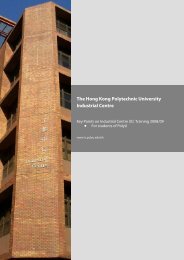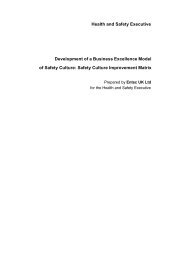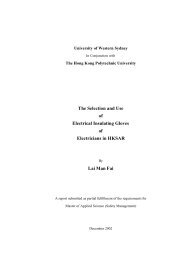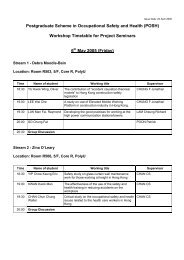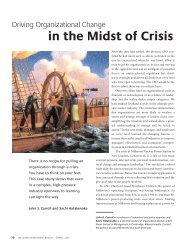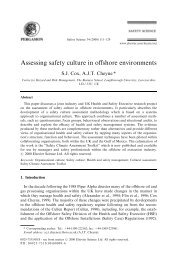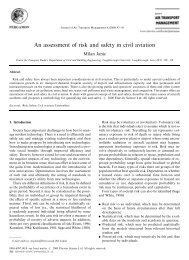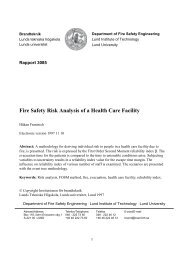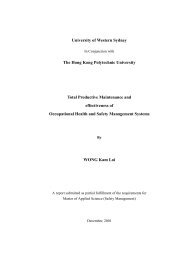Safety culture: transferring theory and evidence ... - Industrial Centre
Safety culture: transferring theory and evidence ... - Industrial Centre
Safety culture: transferring theory and evidence ... - Industrial Centre
- No tags were found...
Create successful ePaper yourself
Turn your PDF publications into a flip-book with our unique Google optimized e-Paper software.
Behavioural Research in Road <strong>Safety</strong>: 10th Seminarincreasingly important in bridging European <strong>and</strong> North American approaches to riskmanagement, to high reliability organisations, <strong>and</strong> to the investigation <strong>and</strong> prevention oflarge-scale accidents. The increasing globalisation of many systems of production <strong>and</strong>finance, <strong>and</strong> dependence upon organisational systems as we approach the millennium <strong>and</strong>beyond, means that these factors are of increasingly wider relevance.In traditional ‘high hazard’ industries such as nuclear, petrochemicals <strong>and</strong> aviation it isbelieved that organisational <strong>culture</strong> presents us with the next critical frontier in accidentprevention efforts as, increasingly, many of the more obvious technical <strong>and</strong> human factorsroutes for safety improvement are exhausted. Furthermore, attempts to measure <strong>and</strong>improve safety <strong>culture</strong> are moving beyond these industries into more mundaneorganisational contexts where routine accidents occur (HSE, 1997). In the roadtransportation context one can pose the question of whether some part of the variance infleet driver behaviour, <strong>and</strong> consequent accidents, might be understood in relation to thenew <strong>theory</strong> <strong>and</strong> empirical research being generated by safety <strong>culture</strong> research?Moving from an initial concern with the modelling of organisational preconditions tofailure or hazard contemporary researchers <strong>and</strong> practitioners are now concerned to specifyhow knowledge of such factors might be used to enhance safety. Chernobyl again marks acritical juncture. Considerable <strong>evidence</strong> was available prior to 1986 of the very severeproblems of control posed by administrative failures of foresight in complex socio-technicalsystems (Turner 1976, 1978). And while the earlier Three Mile Isl<strong>and</strong> accident in the USAhad been interpreted, by Perrow (1984) at least, as <strong>evidence</strong> for the inevitability of seriousaccidents in certain forms of complex system (of which nuclear power plants were hisparadigm example), the organisational errors <strong>and</strong> violations of operating procedures whichcontributed in part to the Chernobyl disaster were interpreted by commentators to be<strong>evidence</strong> of a ‘poor safety <strong>culture</strong>’, both at this plant <strong>and</strong> within the former Soviet Unionnuclear industry more generally (OECD Nuclear Agency 1987).Of course, in the late 1980s this hypothesis stemmed much more from a rhetorical attemptto reassure Western publics that Chernobyl couldn’t happen here, than from any direct orsystematic social science analysis of the deep <strong>and</strong> complex issues involved in this question.Hence, our own research group’s review of the immediate post-Chernobyl discussions ofsafety <strong>culture</strong> critiqued its reduction to a combination of administrative procedures <strong>and</strong>individual attitudes to safety (Turner et al 1989), which seemed to us to be at the expense ofthe wider organisational issues. What was crucially missing, both then <strong>and</strong> in manycontemporary treatments, was the shared characteristic of all social organisation <strong>and</strong><strong>culture</strong>.Implicit in the original claims is the assumption that if the Chernobyl accident – or theKing’s Cross Underground fire in London, or the Exxon Valdez accident in Alaska – couldindeed be put down to a ‘poor’ safety <strong>culture</strong>, then there might surely be something, forwant of a better word, called a ‘good’ safety <strong>culture</strong>, which safety managers might thenpromote, design, or encourage in order to head off some of the worst consequences oforganisational-system failure? In the 1990s, therefore, interest in the topic of safety <strong>culture</strong>has burgeoned as engineers, risk managers <strong>and</strong> nuclear safety practitioners, <strong>and</strong> evenindustrialists, have attempted to operationalize the concept <strong>and</strong> to judge its significance. Inparallel, both risk management consultants, <strong>and</strong> to a lesser extent the applied social scienceresearch communities, have responded with a variety of conceptual frameworks (of varyingdegrees of theoretical grounding) <strong>and</strong> a rapidly exp<strong>and</strong>ing empirical research literature,particularly in Europe (see Cox <strong>and</strong> Flin, 1998).50



